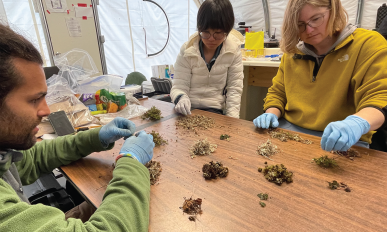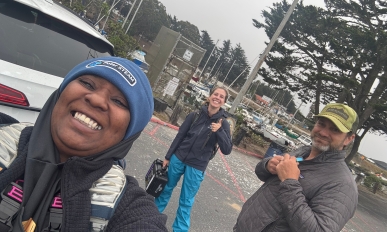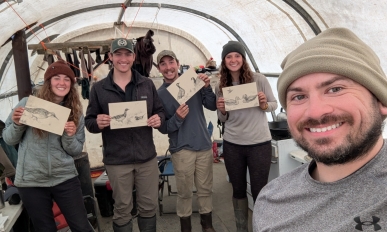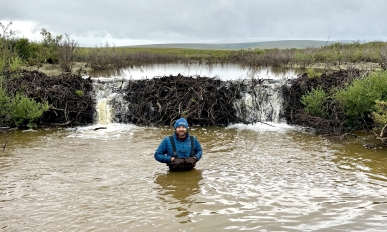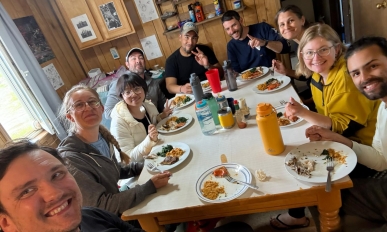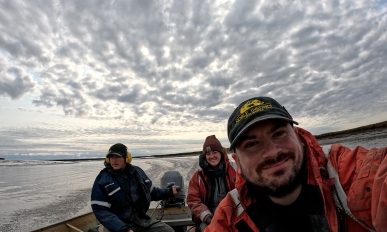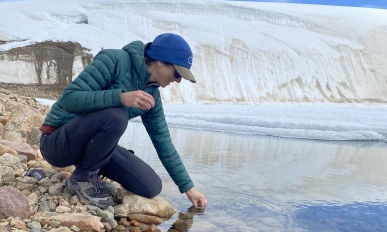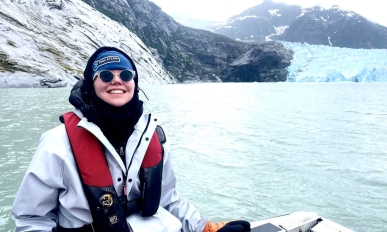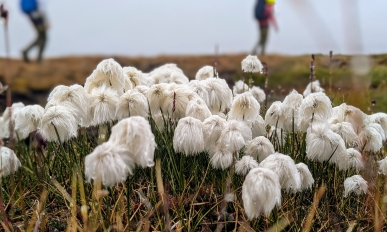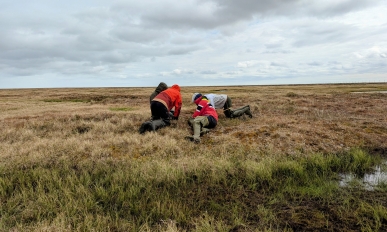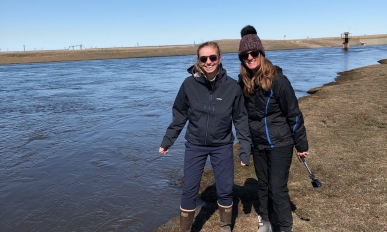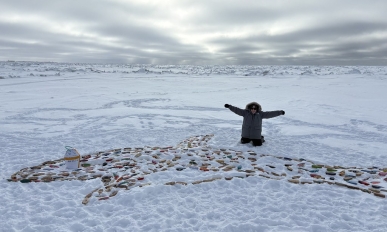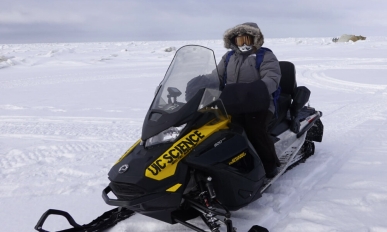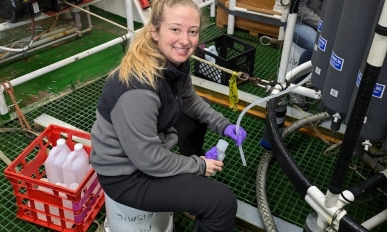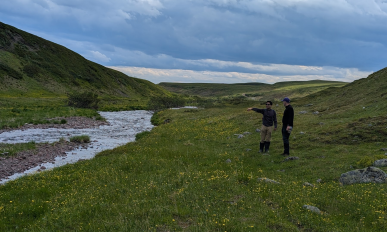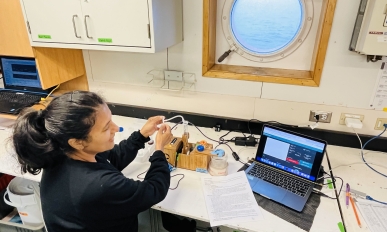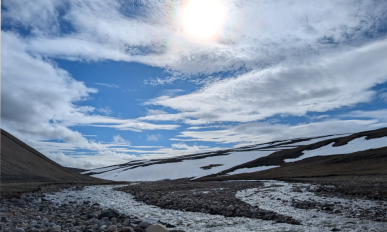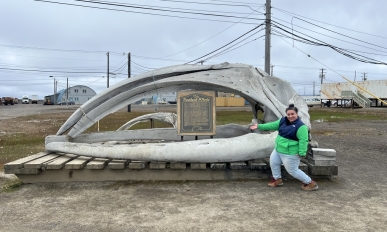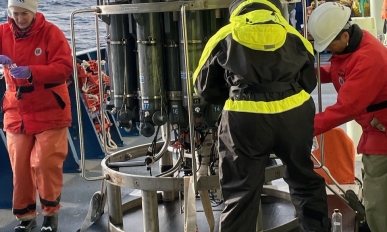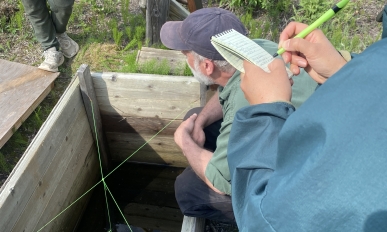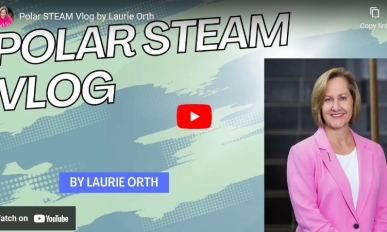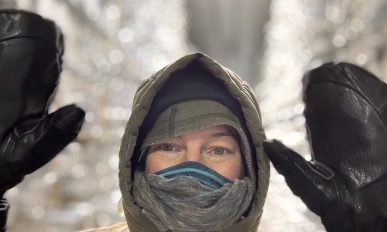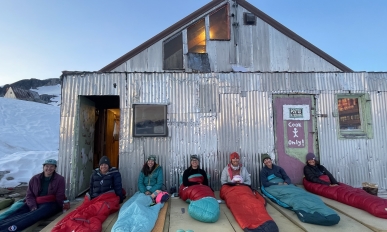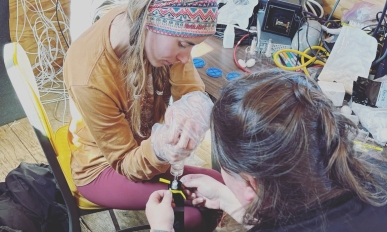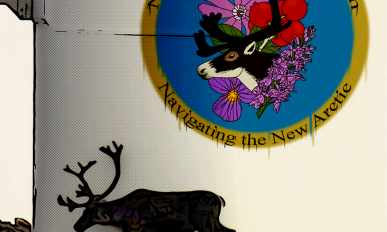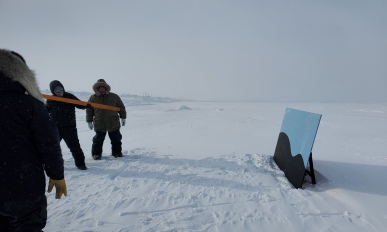My journey starts at Toolik Field Station (TFS), a research station located 370 miles north of Fairbanks, Alaska at Toolik Lake with an interdisciplinary group of Co-Principle Investigators (Co-PIs) and graduate students from three different institutions. As Arctic permafrost thaws, carbon that has been sequestered, or frozen in the ground for thousands of years, can
Never in my wildest dreams did I imagine I would “spawn” in the middle of the Pacific Ocean! As a gaming school library media specialist from the inner city, my career path has taken many unexpected turns, but nothing quite like this: an adventure to Southern California to study whales alongside an inspiring and super
Meet the Team I am so grateful that during my time in the field, I was part of such an incredible team. When it comes to remote field work, the dynamic of a team can make a tremendous difference in the way that problems are solved, challenges are addressed, and morale is maintained. It has
Before I left for the Alaskan Arctic this summer, I carried a quote from Octavia Butler with me: “All that you touch you change. All that you change changes you.” I thought I understood it. But standing for the first time on the tundra, under a sun that seemingly refused to set, I realized I
I miss my new family. Don’t get me wrong—I love my family at home very much. This adventure would not have been possible without the support of my wife and daughter. But I also miss the new family I found in the Arctic. I traveled north to conduct field research, to participate in a science
The “Tut” “I am definitely not in Louisiana anymore.” This was the thought that crossed my mind as I watched the vastness of the Alaskan tundra pass beneath from the small window of a bush plane. As I pondered the thousands of ponds and lakes, an innumerable mosaic of glacial melt atop a layer of
It’s early July, but in Qaanaaq, Kalaallit Nunaat (Greenland) Dr. Eric Klein and his research team are preparing for winter. They are retrieving pressure transducers (data loggers) that measure water level and temperature from the West Qaanaaq River and uploading the data onto a field computer. It’s exciting to see the data come to life
The glacier is mad at us today. That’s the general assessment making its way through the ship, as calving event after calving event sends ice crashing into the water. The team was hoping to send Polly, the remote-controlled RHIB (Rigid Hull Inflatable Boat) that the team uses to deploy moorings and other instruments along the
We started Sunday with a team ritual: reading poems aloud. Some were fun, some serious, all genuine. Afterward came “call-outs,” where team members recognized each other’s efforts, followed by a weather update—crucial for planning fieldwork in the Arctic. These routines, carried out without fuss, reflected how much intention goes into maintaining a strong team culture.
I’ve spent the past six days in Utqiaġvik (Barrow), Alaska, embedded with a group of young scientists working for NEON -the National Ecological Observatory Network. NEON is a large-scale project funded by the NSF that collects long-term, open-access ecological data across the U.S. to track changes in ecosystems over time. And here, at the northernmost
All the Plans Coming Together In late January, I found out I had been selected as a Polar STEAM fellow and would be traveling to Prudhoe Bay, Alaska, with Dr. Julia Guimond and her research team from Woods Hole Oceanographic Institution. I was joining her team to study saltwater intrusion on the North Slope of
What started as a fun fact about myself, “I went from the Amazon Rainforest to the Arctic Circle in less than a week!”, became much more than an entertaining anecdote. It has become a powerful experience in place-based education, global connection, and learning across two of the world’s most remote regions. From March through April
As an educator, I’ve always believed in the power of hands-on learning, the idea that the most profound lessons come when students are actively engaged, not just in a classroom, but in real-world environments. That belief flourished when I was privileged enough to participate as an Educator Fellow with the Polar STEAM program. The Polar
I’m here as an Educator Fellow with Polar STEAM. My goal is to bring the important work that’s happening down here to my students and make it accessible and relevant to us in Kansas. In order to accomplish that goal, though, I have to actually be a part of the scientific research that’s taking place.
“Do you think they do delivery?” Aleksey asks with a grin as he looks back at our last boxes of cookies. For the past nine days, we’ve been camped out in a Reindeer police cabin in the Varanger Peninsula in northeastern Norway. This is our first cool evening of the trip, and the mosquito net-wrapped windows are coated with what we’ve been calling “yr,” the Norwegian word for mist.
Preparing for an expedition to the Southern Ocean is an adventure in itself. You gather your base layers, boots, goggles, socks, and pack your camera and lenses, envisioning the polar environment—one of the most extreme on Earth. Imagine the biting wind on your cheeks and the sight of albatrosses, prions, penguins, humpback whales, and orcas, thriving in such harsh conditions. The excitement is palpable as you prepare to study the microscopic world that sustains this vast ecosystem. Beneath the icy waters lies an invisible world of phytoplankton, microscopic organisms that are the unsung heroes of the marine ecosystem. Despite their size, phytoplankton play a colossal role in maintaining life on Earth.
I thought I had seen all of the colors of blue before my trip to the Far North. After all, I teach about the electromagnetic spectrum and the active and passive sensors that scientists use to understand our changing planet. And yet. There were blues in Kalaallit Nunaat that I had never seen before. While photographs don’t really capture the vibrancy of the colors, or the feeling of being there, they are a starting point for conveying what I mean.
Polar STEAM brought me to Utqiaġvik in collaboration with Dr. Julia York from the University of Illinois. Dr. York’s post-doctoral work is investigating how Arctic fishes, specifically Iqalugaq (Boreogadus saida, Arctic Cod) and Uugaq (Eleginus gracilis, Saffron Cod), physiologically sense and adapt to the freeze thaw cycles that dominate the Arctic throughout the year. Unlike
My whirlwind polar adventure is coming to an end. After a very short 10 days (ALL DAY as the sun has not set in Alaska since mid-May), I find myself spending my last few hours in town reflecting on my experience both with the people as well as the research I helped with, all while admiring the tundra. Polar STEAM brought me to Utqiaġvik in collaboration with Dr. Julia York from the University of Illinois. Dr. York’s post-doctoral work is investigating how Arctic fishes, specifically Iqalugaq (Boreogadus saida, Arctic Cod) and Uugaq (Eleginus gracilis, Saffron Cod), physiologically sense and adapt to the freeze thaw cycles that dominate the Arctic throughout the year. Unlike some of the Antarctic fishes that Dr. York focused on during her PhD, Arctic cod experience a wider range of temperatures throughout the year, from freezing ocean water (28.4°F; -2°C) in the winter to up to mid-40s°F during the summer. Fishes are the same temperature as their environment and environmental temperature fluctuation means that during times of the year fishes must either swim away from the freezing water or adapt mechanisms to keep from freezing.
The US academic research vessel RV Neil Armstrong departed from Nuuk, Greenland in early October. On the first leg of our journey, the science team’s initial purpose was to collect water samples and previously deployed instruments along a line of moorings at the southern entrance to Baffin Bay, a gateway between the Arctic and the north Atlantic. This line stretches from Sisimiut, on the west side of Greenland, to just off Cape Dyer, near the Canadian coast.
Our plane glides through the Endicott Mountains of the Brooks Range as we make our final descent into Anaqtuuvak. Accessible only by plane, Anaktuvuk Pass (“the place of caribou droppings”) is located 250 miles northwest of Fairbanks and is home to the only community of inland Iñupiat, Nunamiut, people [1]. Below, icy blue glaciers feed into a winding network of streams that snake through dense, green tundra and low-lying willows that line the banks of the Anaktuvuk River. From the air, the tundra is a verdant forest, but once on the ground the trees and shrubbery are no taller than 5-6 feet. The village stands out like a colorful flower within the greenery, blooming into view as we enter the valley. In Anaktuvuk, the roots of plants and people alike extend down into permafrost, the lifeblood of the ecosystem and holder of history.
In July 2024 I had the opportunity to visit Amy in person in Arizona. In the vlog of my trip, I share pictures of the work one of Amy’s colleagues is doing on a telescope that is going in a hot air balloon in Antarctica, we visit Kitt Peak Observatory, which is built on the tribal land of the Tohono Odham nation, and then Amy’s lab at the University of Arizona. You will also hear snippets of the songs I wrote for our Polar STEAM resource assignment.
As a high school science teacher, I’m always looking for ways to inspire my students with real-world science and deepen their understanding of our planet. The PolarSTEAM Educator Fellowship has been an extraordinary opportunity to merge my passion for polar environments with my teaching. Through this year-long virtual collaboration with T.J. Fudge, a research scientist at the University of Washington, I’ve been immersed in cutting-edge research on ice cores, allowing me to bring current polar science research to my students.
The Juneau Icefield is a group of interconnected glaciers just north of Juneau, Alaska that extends into British Columbia, Canada and covers an area the size of Rhode Island. Maybe you’ve heard of the Mendenhall Glacier? It is part of the Juneau Icefield! The Juneau Icefield Research Program (JIRP) has been collecting data on the icefield since 1948.
An Unforgettable Adventure Begins As a high school science teacher, the invitation to join Macall Hock on an expedition to study the effects of a warming Arctic ecosystem on stream carbon cycling in Utqiagvik, Alaska, felt like stepping into a thrilling adventure. The beauty of the Arctic wilderness was a sight to behold, but the
Drs. Peter Ungar, Mary Heskel, and Aleksey Sheshukov explained (patiently) their areas of expertise, Arctic research projects, and provided me with a virtual mountain of photographs from their fieldwork. We talked about what projects would be suitable and appropriate for a variety of audiences. What would be engaging to different ages, interests and levels of scientific knowledge? I knew that I wanted my Photoshop class to be involved with this project, so I suggested creating a comic book.
Today we got set up and met the local 8th graders out on the ice! For some of them it was the first time they had been on the land-fast sea ice (which is ice that is “fastened” to the coastline). For some, it was old news. It was quite cold (-30F with the windchill), so many students hid in the tents we had set up. The previous days had been relatively warm, hovering around 0-10F degrees. The students were split into groups and rotated between the stations.
